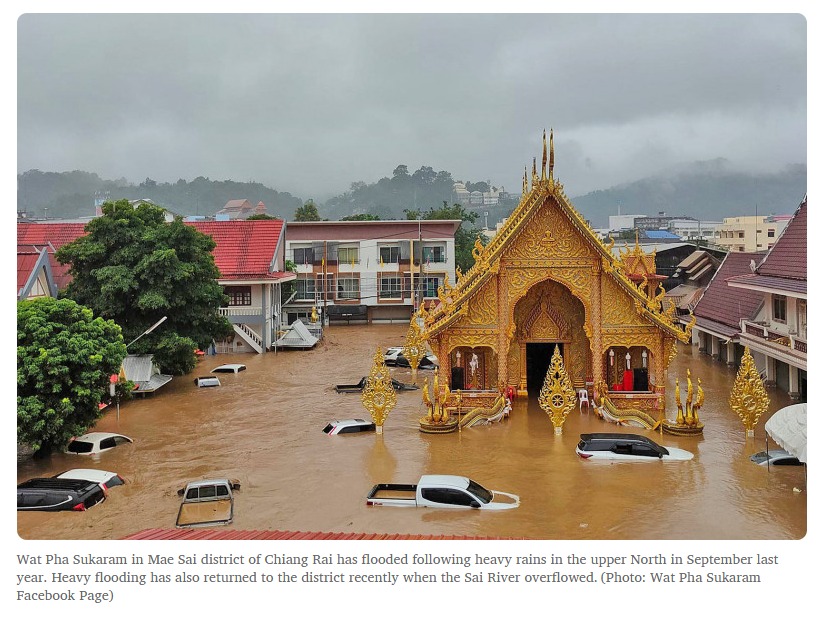
G-Union
News
Jun 02, 2025

Mae Sai must learn how to live with annual floods, while protecting its assets and way of life
Last year, floods in Mae Sai district of Chiang Rai province caused economic losses in the millions.
Experts believe this could be the beginning of an annual pattern of damage caused by severe natural disasters.
In May alone, Mae Sai, a border town opposite Myanmar's Tachileik to the west and 900km north of Bangkok, flooded twice.
A mass of water from the Sai River rushed through the city. Gold and rare earth mining in Myanmar was said to be the culprit, as well as mega-scale single crop plantations.
These activities led to large-scale deforestation which worsens flooding.
Wannasin Keerakad, municipal clerk of Mae Sai subdistrict municipality, recalled how locals were never affected by floods on the scale seen today.
The expansion of the town, which led to intrusion along the river bank, combined with the absence of fertile forest to absorb the floodwater, has contributed to the worsening damage.
The town is home to some 20,000 residents, according to the civil registration system, but when combined with those not registered, that number could be double, he said.
Buildings illegally constructed on the river bank create a narrower natural waterway.
"We don't just suffer from floods, but mud also. The Sai River has carried several tonnes of mud [from the Myanmar side] and hit the town. The situation will become worse if the mining continues," he said.
Mr Wannasin said the scale of the flooding in Mae Sai is beyond the capacity of the local administration to manage. Mae Sai needs serious action from the government to save it, he added.
In the past, a flood was considered heavy if the amount of rainfall exceeded 100 millimetres. But now, a small volume of rainfall of just around 60mm has a huge impact on the town, a result of a shallow river caused by a huge amount of sediment.
He added that Mae Sai urgently needs a permanent 3.6-kilometre floodwall, which he said might be the most effective measure, as well as increasing the river's water flow capacity.
Residents whose homes intrude along the river bank have agreed to demolish them, but the government should offer to assist them in finding a new home, he said.
Mae Sai is a major border crossing between Thailand and Myanmar; the town of Tachileik, in Shan State is across the bridge.
Last September, the two cities were devastated by heavy floods and a sea of mud. It took two months to clean up Mae Sai.
The two towns then agreed to set up a 40-metre no-construction buffer zone to expand the river's bank.
All illegal buildings in the zone must be demolished. But no progress has been made on the issue so far.
Meanwhile, 74.8 million baht has been invested to dredge the Sai River and the Ruak River along a 30.9-kilometre stretch to increase water flow capacity in the rainy season.
It is expected to be completed next month, says the Office of the National Water Resources.
Anek Siripanichgorn, a Council of Engineers Thailand board member and chairman of a working group on natural disasters, said the town needs "special town planning " to respond to the high risk of flooding.
It needs a water retention zone and floodway to divert water running into the city. He said a floodwall alone might not solve the problem.
"The challenge is the sea of mud running from the deforested mountains in Myanmar.
"The floodwall might need to be repaired every year due to strong water currents and a massive amount of mud in torrential rain," he said.
The town needs to start adapting to learn how to live with annual floods, while protecting assets and the way of life, otherwise it may have to start planning to relocate.
Meanwhile, Tara Buakamsri, an adviser to Greenpeace Southeast Asia's Thailand office, said Asean's cooperative mechanism has been insufficient to address current climate problems. Flooding in Mae Sai is a significant example of transboundary environmental impacts.
The Asean agreement on haze transboundary pollution is only one mechanism to address environmental issues. Unfortunately, it has produced poor results because cooperation is on a voluntary basis and the non-interference principle.
"We would like to see more action from the government, whether it is the flood issue in Mae Sai, or on the heavy metal contamination in a northern river from mining activities in Shan State," he said. "In the long term, regional security on health and the environment will be at stake."
Close cooperation between locals is also important. Townspeople on both sides of the border can develop early warning systems to help limit losses, he said.
He also said it might be possible to have the Mekong River Commission raise the issue with China concerning poor environmental practices by certain Chinese firms as a means of alleviating the problem.